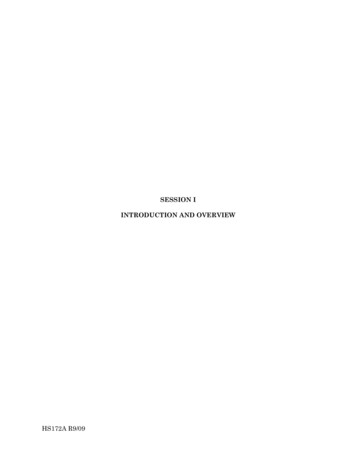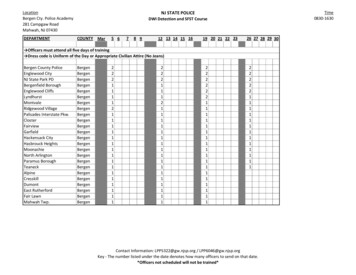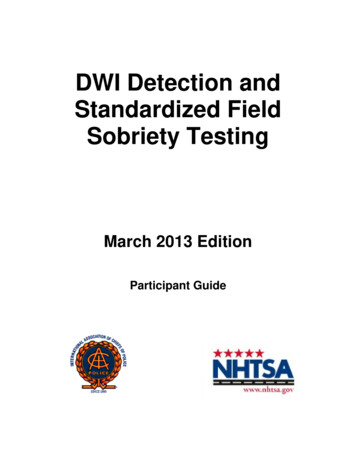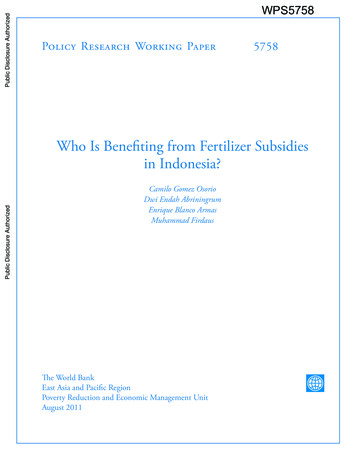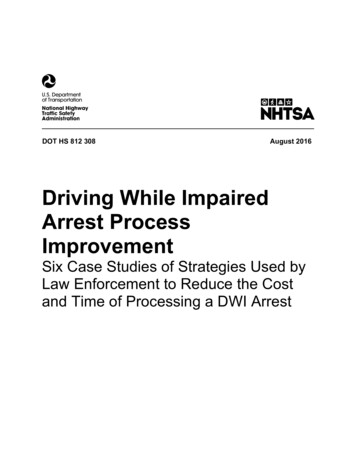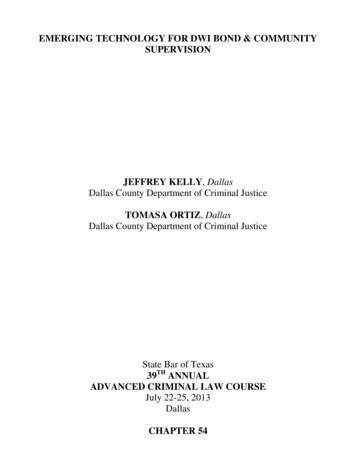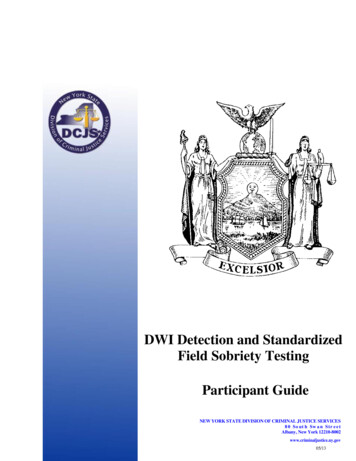
Transcription
DWI Detection and StandardizedField Sobriety TestingParticipant GuideNEW YORK STATE DIVISION OF CRIMINAL JUSTICE SERVICES8 0 So ut h Sw a n Str e e tAlbany, New York 12210-8002www.criminaljustice.ny.gov05/13
COPYRIGHT NOTICECopyright 2013 by the New York State Division of Criminal Justice Services. This publicationmay be reproduced without the express written permission of the New York State Division ofCriminal Justice Services provided that this copyright notice appears on all copies or segments ofthe publication.The 2013 edition is published by theNew York StateDivision of Criminal Justice ServicesOffice of Public SafetyAlfred E. Smith Office Building 3rd Floor80 South Swan StreetAlbany, New York 12210-8002HTTP://criminaljustice.ny.govVERSION May 2013PRINTED IN THE UNITED STATES OF AMERICA
PrefaceIn the years past, regular modifications have been made in the DWI Detection andStandardized Field Sobriety Testing Course curricula. The program commenced in the State ofNew York as the Impaired Driver Recognition Course (IDRP) in the 1980's. The IDRP coursewas the same program presented in other states as the Standardized Field Sobriety TestingCourse. In 1996, the New York State Municipal Police Training Council (MPTC) adopted theDWI Detection and Standardized Field Sobriety Testing Course produced by the InternationalAssociation of Chiefs of Police (IACP) and the National Highway Traffic Safety Administration(NHTSA) as a training standard. Since its inception, this important program has been presentedto thousands of officers across the State of New York.Officers trained in the Impaired Driver Recognition Course or earlier versions of theDWI Detection and Standardized Field Sobriety Testing Course remain qualified to administerand interpret the SFST’s based on their previous training.Part 6022 of Title 9 of the Official Compilation of Codes, Rules and Regulations of the State ofNew York (NYCRR) specifies that instructors in MPTC approved programs, like this one, shallbe certified instructors pursuant to 9 NYCRR 6023. In addition, instructors must have completedthe DWI Detection and Standardized Field Sobriety Testing Instructor Course to present thiscourse.Accordingly, this curriculum establishes the minimum standards as approved by the MunicipalPolice Training Council. The material has been updated by IACP/NHTSA to better reflectcurrent methods of identification of impaired drivers in our communities today.
DWI DETECTIONANDSTANDARDIZED FIELD SOBRIETY TESTINGI.Introduction and OverviewII.Detection and General DeterrenceIII.The Legal EnvironmentIV.Overview of Detection, Note-Taking and TestimonyV.Phase One: Vehicle in MotionVI.Phase Two: Personal ContactVII.Phase Three: Pre-arrest ScreeningVIII.Concepts and Principles of the Standardized Field Sobriety TestsIX.Test Battery DemonstrationsX."Dry Run" Practice SessionXI."Testing Subjects" Practice: First SessionXII.Processing the Arrested Suspect and Preparation for TrialXIII.Report Writing Exercise and Moot CourtXIV."Testing Subjects" Practice: Second SessionXV.Review and Proficiency ExaminationsXVI.Written Examination and Program Conclusion
PREFACEThe procedures outlined in this manual describe how the Standardized Field Sobriety Tests(SFSTs) are to be administered under ideal conditions. We recognize that the SFSTs will notalways be administered under ideal conditions in the field, because such conditions will notalways exist. Even when administered under less than ideal conditions, they will generally serveas valid and useful indicators of impairment. Slight variations from the ideal, i.e., the inability tofind a perfectly smooth surface at roadside, may have some affect on the evidentiary weightgiven to the results. However, this does not necessarily make the SFSTs invalid.
SFST Session 1 – Introduction and OverviewSession 1 - IntroductionNotes:DWI Detection and StandardizedField Sobriety TestingStandard ized Field Sobriety Test CourseSession 1 - Introduction30 MinutesSession 1Introductionand OverviewStandard ized Field Sobriety Test Course1-2Session 1 - IntroductionHousekeeping Paperwork Mandatory attendance Breaks Facility Interruptions All electronic devices offStandard ized Field Sobriety Test CourseHS 178 R5/131-3Notes:Notes:1 of 24
Session 1 - IntroductionParticipant Introductions Name Agency Duty assignment ExperienceStandard ized Field Sobriety Test Course1-4Notes:Session 1 - IntroductionLearning Objectives Course goals and objectives Course schedule and activities Participant Manual contents Pre-training knowledgeStandard ized Field Sobriety Test CourseNotes:1-5Upon successfully completing this session the participant will be able to: State the goals and objectives of the course Describe the course schedule and activities Recognize the Participant Manual contents Demonstrate their pre-training knowledge of course topicsCONTENT SEGMENTSLEARNING ACTIVITESA. Welcoming Remarks and ObjectivesInstructor Led PresentationsB. Administrative DetailsWritten ExaminationC. Pre-TestHS 178 R5/132 of 24
Session 1 - IntroductionCourse GoalIncrease deterrence of DWI violations;thereby reducing the number of crashes,deaths, and injuries caused by impaireddrivers.Standard ized Field Sobriety Test Course1-6Notes:The goal of this course is to ultimately increase deterrence of DWI violations; therebyreducing the number of crashes, deaths, and injuries caused by impaired drivers.Session 1 - IntroductionSession 1 - IntroductionEnforcementEnforcement GoalsGoals Enforcement’sEnforcement’s rolerole inin generalgeneral DWIDWIdeterrencedeterrence DWIDWI detectiondetection phases,phases, clues,clues, andandtechniquestechniques RequirementsRequirements forfor organizingorganizing andandpresentingpresenting evidenceevidence inin DWIDWI casescasesStandard ized Field Sobriety Test CourseStandard ized Field Sobriety Test Course1-71-7Notes:Enforcement goals are to identify: Enforcement’s role in general DWI deterrence DWI detection phases, clues and techniques Requirements for organizing and presenting testimonial and documentary evidencein DWI casesHS 178 R5/133 of 24
Session 1 - IntroductionImpaired Drivers Kill or Injure aPerson Every Minute!65 deaths and injuries each hour!1-8Standard ized Field Sobriety Test CourseNotes:65 deaths and injuries each hour!Session 1 - IntroductionState and Local Data Approximately people now livein . About of these people will die invehicle crashes. About will die in DWI crashes.Standard ized Field Sobriety Test Course 1-9Notes:Approximately people now live in .About of these people will die in vehicle crashes.About will die in DWI crashes.HS 178 R5/134 of 24
Session 1 - IntroductionJob Performance Objectives Recognize and interpret evidence ofDWI violations Administer and interpret StandardizedField Sobriety Tests (SFSTs) Describe DWI evidence clearly andconvincingly Ensure video and/or audio evidence ifavailable is consistent with otherevidenceStandard ized Field Sobriety Test Course1-10Notes:At the conclusion of this training, participants will demonstrate the ability to: Recognize and interpret evidence of DWI violationsAdminister and interpret Standardized Field Sobriety TestsDescribe DWI evidence clearly and convincingly in written reports and verbaltestimonyEnsure video and/or audio evidence, if available, is consistent with other evidenceHS 178 R5/135 of 24
Session 1 - IntroductionJob Performance Objectives Recognize and interpret evidence ofDWI violations Administer and interpret StandardizedField Sobriety Tests (SFSTs) Describe DWI evidence clearly andconvincingly Ensure video and/or audio evidence ifavailable is consistent with otherevidenceStandard ized Field Sobriety Test Course1-10Notes:Job Performance Enabling Objectives Understand the tasks and decisions of DWI detection.Recognize the magnitude and scope of DWI-related crashes, deaths, injuries,property loss and other social aspects of the DWI problem.Understand the deterrent effects of DWI enforcement.Understand the DWI enforcement legal environment.Know and recognize typical vehicle maneuvers and human indicators symptomaticof DWI that are associated with initial observation of vehicles in operation.Know and recognize typical reinforcing maneuvers and indicators that come to lightduring the stopping sequence.Know and recognize typical sensory and other clues of alcohol and/or other drugimpairment that may be seen during face to face contact with DWI subjects.Know and recognize typical behavioral clues of alcohol and/or other drugimpairment that may be seen during the subject's exit from the vehicle.Understand the role and relevance of psychophysical testing in pre-arrest screeningof DWI subjects.Understand the role and relevance of preliminary breath testing in pre-arrestscreening of DWI subjects.Know and carry out appropriate administrative procedures for the Horizontal GazeNystagmus test.Know and carry out appropriate administrative procedures for validated dividedattention psychophysical tests.Know and recognize typical clues of alcohol and/or other drug impairment that maybe seen during administration of the SFSTs.Understand the factors that may affect the accuracy of preliminary breath testingdevices.Understand the elements of DWI prosecution and their relevance to DWI arrestreporting.Choose appropriate descriptive terms to convey relevant observations of DWIevidence.Write clear, descriptive narrative DWI arrest reports.HS 178 R5/136 of 24
Participant ManualSession 1 - IntroductionParticipant Manual Basic course referenceClass notes for every sessionManual organizationPreview sessions in advanceReview prior to examStandard ized Field Sobriety Test Course1-13Notes:The Participant Manual is the basic reference document for this course. The manualcontains thumbnails of each instructor presentation that includes key messages for eachframe. The manual also contains a glossary of terms that are used in this course. Read each session prior to class. Use the manual to review the material prior to taking the final exam.Session 1 - IntroductionQUESTIONS?Notes:Standard ized Field Sobriety Test CourseHS 178 R5/137 of 24
Glossary of TermsSession 1 - IntroductionGlossary of TermsSFSTSFST Glossaryof TermsStandard ized Field Sobriety Test Course1-15Notes:SFST Master Glossary of TermsACCOMMODATION REFLEXThe adjustment of the eyes for viewing at various distances. Meaning the pupilswill automatically constrict as objects move closer and dilate as objects movefurther away.ADDICTIONHabitual, psychological, and physiological dependence on a substance beyondone’s voluntary control.ADDITIVE EFFECTOne mechanism of polydrug interaction. For a particular indicator of impairment,two drugs produce an additive effect if they both affect the indicator in the sameway. For example, cocaine elevates pulse rate and PCP also elevates pulserate. The combination of cocaine and PCP produces an additive effect on pulserate.AFFERENT NERVESSee: "Sensory Nerves."ALKALOIDA chemical that is found in, and can be physically extracted from, somesubstance. For example, morphine is a natural alkaloid of opium. It does notrequire a chemical reaction to produce morphine from opium.ALVEOLAR BREATH - Breath from the deepest part of the lung.ANALGESICA drug that relieves or allays pain.HS 178 R5/138 of 24
ANALOG (of a drug)An analog of a drug is a chemical that is very similar to the drug, both in terms ofmolecular structure and in terms of psychoactive effects. For example, the drugKetamine is an analog of PCP.ANESTHETICA drug that produces a general or local insensibility to pain and other sensation.ANTAGONISTIC EFFECTOne mechanism of polydrug interaction. For a particular indicator of impairment,two drugs produce an antagonistic effect if they affect the indicator in oppositeways. For example, heroin constricts pupils while cocaine dilates pupils. Thecombination of heroin and cocaine produces an antagonistic effect on pupil size.Depending on how much of each drug was taken, and on when they were taken,the suspect's pupils could be constricted, or dilated, or within the normal range ofsize.ARRHYTHMIAAn abnormal heart rhythm.ARTERYThe strong, elastic blood vessels that carry blood away the heart.ATAXIAA blocked ability to coordinate movements. A staggering walk and poor balancemay be caused by damage to the brain or spinal cord. This can be the result oftrauma, birth defect, infection, tumor, or drug use.AUTONOMIC NERVEA motor nerve that carries messages to the muscles and organs that we do notconsciously control. There are two kinds of autonomic nerves, the sympatheticnerves and parasympathetic nerves.AXONThe part of a neuron (nerve cell) that sends out a neurotransmitter.BAC(Blood Alcohol Concentration) - The percentage of alcohol in a person’s blood.BrAC(Breath Alcohol Concentration) - The percentage of alcohol in a person’s bloodas measured by a breath testing device.HS 178 R5/139 of 24
BLOOD PRESSUREThe force exerted by blood on the walls of the arteries. Blood pressure changescontinuously, as the heart cycles between contraction and expansion.BRADYCARDIAAbnormally slow heart rate; pulse rate below the normal range.BRADYPNEAAbnormally slow rate of breathing.BRUXISMGrinding the teeth. This behavior is often seen in person who are under theinfluence of cocaine or other CNS Stimulants.CANNABISThis is the drug category that includes marijuana. Marijuana comes primarilyfrom the leaves of certain species of Cannabis plants that grow readily all overthe temperate zones of the earth. Hashish is another drug in this category, and ismade from dried and pressed resin of a marijuana plant. The active ingredient inboth Marijuana and Hashish is a chemical called delta-9 tetrahydrocannabinol,usually abbreviated THC.This is the drug category that includes MariCARBOXY THCA metabolite of THC (tetrahydrocannabinol).CHEYNE- STOKES RESPIRATIONAbnormal pattern of breathing. Marked by breathlessness and deep, fastbreathing.CLUE - Something that leads to the solution of a problem.CNS (Central Nervous System)A system within the body consisting of the brain, the brain stem, and the spinalcord.CNS DEPRESSANTSOne of the seven drug categories. CNS Depressants include alcohol,barbiturates, anti-anxiety tranquilizers, and numerous other drugs.CNS STIMULANTSOne of the seven drug categories. CNS Stimulants include Cocaine, theAmphetamines, Ritalin, Preludin, and numerous other drugs.HS 178 R5/1310 of 24
CONJUNCTIVITISAn inflammation of the mucous membrane that lines the inner surface of theeyelids caused by infection, allergy, or outside factors. May be bacterial or viral.Persons suffering from conjunctivitis may show symptoms in one eye only. Thiscondition is commonly referred to as "pink eye", a condition that could bemistaken for the bloodshot eyes produced by alcohol or Cannabis.CONVERGENCEThe "crossing" of the eyes that occurs when a person is able to focus on astimulus as it is pushed slowly toward the bridge of their nose. (See, also, "Lackof Convergence".)CRACK/ROCKCocaine base, appears as a hard chunk form resembling pebbles or small rocks.It produces a very intense, but relatively short duration "high".CUE - A reminder or prompting as a signal to do something. A suggestion or a hint.CURRICULUM VITAEA written summary of a person's education, training, experience, noteworthyachievements and other relevant information about a particular topic.CYCLIC BEHAVIORA manifestation of impairment due to certain drugs, in which the suspectalternates between periods (or cycles) of intense agitation and relative calm.Cyclic behavior, for example, sometimes will be observed in persons under theinfluence of PCP.DELIRIUMA brief state characterized by incoherent excitement, confused speech,restlessness, and possible hallucinations.DENDRITEThe part of a neuron (nerve cell) that receives a neurotransmitter.DIACETYL MORPHINEThe chemical name for Heroin.DIASTOLICThe lowest value of blood pressure. The blood pressure reaches its diastolicvalue when the heart is fully expanded, or relaxed (Diastole).DIPLOPIADouble vision.HS 178 R5/1311 of 24
DISSOCIATIVE ANESTHETICSOne of the seven drug categories. Includes drugs that inhibits pain by cutting offor disassociating the brain's perception of pain. PCP and its analogs areconsidered Dissociative Anesthetics.DIVIDED ATTENTIONConcentrating on more than one thing at a time. The four psychophysical testsused by DREs require the suspect to divide attention.DIVIDED ATTENTION TESTA test which requires the subject to concentrate on both mental and physicaltasks at the same time.DOWNSIDE EFFECTAn effect that may occur when the body reacts to the presence of a drug byproducing hormones or neurotransmitters to counteract the effects of the drugconsumed.DRUGAny substance that, when taken into the human body, can impair the ability of theperson to operate a vehicle safely.DWI/DUIThe acronym "DWI" means driving while impaired and is synonymous with theacronym "DUI", driving under the influence or other acronyms used to denoteimpaired driving. These terms refer to any and all offenses involving theoperation of vehicles by persons under the influence of alcohol and/or otherdrugs.DWI DETECTION PROCESSThe entire process of identifying and gathering evidence to determine whether ornot a subject should be arrested for a DWI violation. The DWI detection processhas three phases:1. Phase One - Vehicle In Motion2. Phase Two - Personal Contact3. Phase Three - Pre-arrest ScreeningDYSARTHIASlurred speech. Difficult, poorly articulated speech.DYSPNEA et. al.Shortness of breath.HS 178 R5/1312 of 24
DYSMETRIAAn abnormal condition that prevents the affected person from properly estimatingdistances linked to muscular movements.DYSPHORIAA disorder of mood. Feelings of depression and anguish.EFFERENT NERVESSee: "Motor Nerves".ENDOCRINE SYSTEMThe network of glands that do not have ducts and other structures. They secretehormones into the blood stream to affect a number of functions in the body.EVIDENCEAny means by which some alleged fact that has been submitted to investigationmay either be established or disproved. Evidence of a DWI violation may be ofvarious types: Physical (or real) evidence: something tangible, visible, or audible. Well established facts (judicial notice). Demonstrative evidence: demonstrations performed in the courtroom. Written matter or documentation. Testimony.EXPERT WITNESSA person skilled in some art, trade, science or profession, having knowledge ofmatters not within knowledge of persons of average education, learning andexperience, may assist a jury in arriving at a verdict by expressing an opinion ona state of facts shown by the evidence and based upon his or her specialknowledge. (NOTE: Only the court can determine whether a witness is qualifiedto testify as an expert.)FIELD SOBRIETY TESTAny one of several roadside tests that can be used to determine whether asubject is impaired.FLASHBACKA vivid recollection of a portion of an hallucinogenic experience. Essentially, it isa very intense daydream. There are three types: (1) emotional -- feelings ofpanic, fear, etc.; (2) somatic -- altered body sensations, tremors, dizziness, etc.;and (3) perceptual -- distortions of vision, hearing, smell, etc.HS 178 R5/1313 of 24
GARRULITYChatter, rambling or pointless speech. Talkative.HALLUCINATIONA sensory experience of something that does not exist outside the mind, e.g.,seeing, hearing, smelling, or feeling something that isn't really there. Also,having a distorted sensory perception, so that things appear differently than theyare.HALLUCINOGENSOne of the seven drug categories. Hallucinogens include LSD, MDMA, Peyote,Psilocybin, and numerous other drugs.HASHISHA form of cannabis made from the dried and pressed resin of a marijuana plant.HASH OILSometimes referred to as “marijuana oil” it is a highly concentrated syrup-like oilextracted from marijuana. It is normally produced by soaking marijuana in acontainer of solvent, such as acetone or alcohol for several hours and after thesolvent has evaporated, a thick syrup-like oil is produced with a higher THCcontent.HEROINA powerful and widely-abused narcotic analgesic that is chemically derived frommorphine. The chemical, or generic name of heroin is "diacetyl morphine".HIPPUSA rhythmic change in the pupil size of the eyes, as they dilate and constrict whenobserved in darkness independent of changes in light intensity, accommodation(focusing), or other forms of sensory stimulation. Normally only observed withspecialized equipment.HOMEOSTASISThe dynamic balance, or steady state, involving levels of salts, water, sugars,and other materials in the body's fluids.HORIZONTAL GAZE NYSTAGMUS (HGN)Involuntary jerking of the eyes occurring as the eyes gaze to the side. The firsttest administered in the SFST battery.HS 178 R5/1314 of 24
HORMONESChemicals produced by the body's endocrine system that are carried through theblood stream to the target organ. They exert great influence on the growth anddevelopment of the individual, and that aid in the regulation of numerous bodyprocesses.HYDROXY THCA metabolite of THC (tetrahydrocannabinol).HYPERFLEXIAExaggerated or over extended motions.HYPERGLYCEMIAExcess sugar in the blood.HYPERPNEAA deep, rapid or labored breathing.HYPERPYREXIAExtremely high body temperature.HYPERREFLEXIAA neurological condition marked by increased reflex reactions.HYPERTENSIONAbnormally high blood pressure. Do not confuse this with hypotension.HYPOGLYCEMIAAn abnormal decrease of blood sugar levels.HYPOPNEAShallow or slow breathing.HYPOTENSIONAbnormally low blood pressure. Do not confuse this with hypertension.HYPOTHERMIADecreased body temperature.ICEA crystalline form of methamphetamine that produces a very intense and fairlylong-lasting "high".ILLEGAL PER SEUnlawful in and of itself. Used to describe a law which makes it illegal to drivewhile having a statutorily prohibited Blood Alcohol Concentration.HS 178 R5/1315 of 24
INHALANTSOne of the seven drug categories. The inhalants include volatile solvents (suchas glue and gasoline), aerosols (such as hair spray and insecticides) andanesthetic gases (such as nitrous oxide).INSUFFLATIONSee "snorting".INTEGUMENTARY SYSTEMThe skin and accessory structures, hair and nails. Functions include protection,maintenance of body temperature, excretion of waste, and sensory perceptions.INTRAOCULAR"Within the eyeball".KOROTKOFF SOUNDSA series of distinct sounds produced by blood passing through an artery, as theexternal pressure on the artery drops from the systolic value to the diastolicvalue.LACK OF CONVERGENCEThe inability of a person's eyes to converge, or "cross" as the person attempts tofocus on a stimulus as it is pushed slowly toward the bridge of his or her nose.MARIJUANACommon term for the Cannabis Sativa plant. Usually refers to the dried leaves ofthe plant. This is the most common form of the cannabis category.MARINOLA drug containing a synthetic form of THC (tetrahydrocannabinol). Marinolbelongs to the cannabis category of drugs, but marinol is not produced from anyspecies of cannabis plant.METABOLISMThe sum of all chemical processes that take place in the body as they relate tothe movements of nutrients in the blood after digestion, resulting in growth,energy, release of wastes, and other body functions. The process by which thebody, using oxygen, enzymes and other internal chemicals, breaks downingested substances such as food and drugs so they may be consumed andeliminated. Metabolism takes place in two phases. The first step is theconstructive phase (anabolism) where smaller molecules are converted to largermolecules. The second steps is the destructive phase (catabolism) where largemolecules are broken down into smaller molecules.HS 178 R5/1316 of 24
METABOLITEA chemical product, formed by the reaction of a drug with oxygen and/or othersubstances in the body.MIOSISAbnormally constricted pupils.MOTOR NERVESNerves that carry messages away from the brain, to be body's muscles, tissues,and organs. Motor nerves are also known as efferent nerves.MUSCULAR HYPERTONICITYRigid muscle tone.MYDRIASISAbnormally dilated pupils.NARCOTIC ANALGESICSOne of the seven drug categories. Narcotic analgesics include opium, the naturalalkaloids of opium (such as morphine, codeine and thebaine), the derivatives ofopium (such as heroin, dilaudid, oxycodone and percodan), and the syntheticnarcotics (such as demerol and numorphan).NERVEA cord-like fiber that carries messages either to or from the brain. For drugevaluation and classification purposes, a nerve can be pictured as a series of"wire-like" segments, with small spaces or gaps between the segments.NEURONA nerve cell. The basic functional unit of a nerve. It contains a nucleus within acell body with one or more axons and dendrites.NEUROTRANSMITTERChemicals that pass from the axon of one nerve cell to the dendrite of the nextcell, and that carry messages across the gap between the two nerve cells.NULL EFFECTOne mechanism of polydrug interaction. For a particular indicator of impairment,two drugs produce a null effect if neither of them affects that indicator. Forexample, PCP does not affect pupil size, and alcohol does not affect pupil size.The combination of PCP and alcohol produces a null effect on pupil size.HS 178 R5/1317 of 24
NYSTAGMUSAn involuntary jerking of the eyes.ONE LEG STAND (OLS)A divided attention field sobriety test. The third test administered in the SFSTbattery."ON THE NOD"A semi-conscious state of deep relaxation. Typically induced by impairment dueto Heroin or other narcotic analgesic. The suspect's eyelids droop, and chin restson the chest. Suspect may appear to be asleep, but can be easily aroused andwill respond to questions.OVERLAPPING EFFECTOne mechanism of polydrug interaction. For a particular indicator of impairment,two drugs produce an overlapping effect if one of them affects the indicator butthe other doesn't. For example, cocaine dilates pupils while alcohol doesn'taffect pupil size. The combination of cocaine and alcohol produces anoverlapping effect on pupil size: the combination will cause the pupils to dilate.PALLORAn abnormal paleness or lack of color in the skin.PARANOIAMental disorder characterized delusions and the projection of personal conflicts,that are ascribed to the supposed hostility of others.PARAPHERNALIADrug paraphernalia are the various kinds of tools and other equipment used tostore, transport or ingest a drug. Hypodermic needles, small pipes, bent spoons,etc., are examples of drug paraphernalia. The singular form of the word is"paraphernalium". For example, one hypodermic needle would be called a "drugparaphernalium".PARASYMPATHETIC NERVEAn autonomic nerve that commands the body to relax and to carry out tranquilactivities. The brain uses parasympathetic nerves to send "at ease" commandsto the muscles, tissues, and organs.PARASYMPATHOMIMETIC DRUGSDrugs that mimic neurotransmitter associated with the parasympathetic nerves.These drugs artificially cause the transmission of messages that produce lowerblood pressure, drowsiness, etc.HS 178 R5/1318 of 24
PDR (Physician's Desk Reference)A basic reference source for drug recognition experts. The PDR providesdetailed information on the physical appearance and psychoactive effects oflicitly-manufactured drugs.PERSONAL CONTACTThe second phase in the DWI detection process. In this phase the officerobserves and interviews the driver face to face; determines whether to ask thedriver to step from the vehicle; and observes the driver's exit and walk from thevehicle.PHENCYCLIDINEA contraction of PHENYL CYCLOHEXYL PIPERIDINE, or PCP. Formerly usedas a surgical anesthetic, however, it has no current legitimate medical use inhumans.PHENYL CYCLOHEXYL PIPERIDINE (PCP)Often called "phencyclidine" or “PCP”, it is a specific drug belonging to theDissociative Anesthetics category.PHYSIOLOGYPhysiology is the branch of biology dealing with the functions and activities of lifeor living matter and the physical and chemical phenomena involved.PILOERECTIONLiterally, "hair standing up", or goose bumps. This condition of the skin is oftenobserved in persons who are under the influence of LSD.POLY DRUG USEIngesting drugs from two or more drug categories.PRE-ARREST SCREENINGThe third phase in the DWI detection process. In this phase the officeradministers field sobriety tests to determine whether there is probable cause toarrest the driver for DWI, and administers or arranges for a preliminary breathtest.PRELIMINARY BREATH TEST (PBT)A pre-arrest breath test administered during investigation of a possible DWIviolator to obtain an indication of the person's blood alcohol concentration.HS 178 R5/1319 of 24
PROBABLE CAUSEIt is more than mere suspicion; facts and circumstances within the officer’sknowledge, and of which he or she has reasonably trustworthy information, aresufficient to warrant a person of reasonable caution to believe that an offensehas been or is being committed.PSYCHEDELICA mental state characterized by a profound sense of intensified or alteredsensory perception sometimes accompanied by hallucinations.PSYCHOPHYSICAL TESTSMethods of investigating the mental (psycho-) and physical characteristics of aperson suspected of alcohol or drug impairment. Most psychophysical testsemploy the concept of divided attention to assess a suspect's impairment.PSYCHOTOGENICLiterally, "creating psychosis" or "giving birth to insanity". A drug is considered tobe psychotogenic if persons who are under the influence of the drug becomeinsane, and remain so after the drug wears off.PSYCHOTOMIMETICLiterally, "mimicking psychosis" or "impersonating insanity". A drug is consideredto be psychotomimetic if persons who are under
In the years past, regular modifications have been made in the DWI Detection and Standardized Field Sobriety Testing Course curricula. The program commenced in the State of New York as the Impaired Driver Recognition Course (IDRP) in the 1980's. The IDRP course was the same program presented in other states as the Standardized Field Sobriety .

